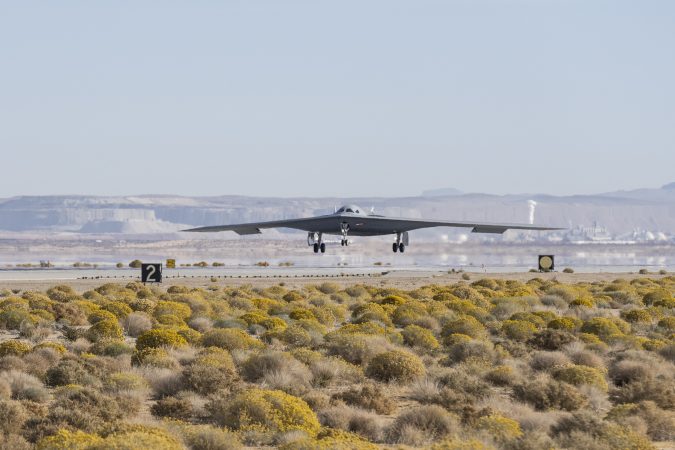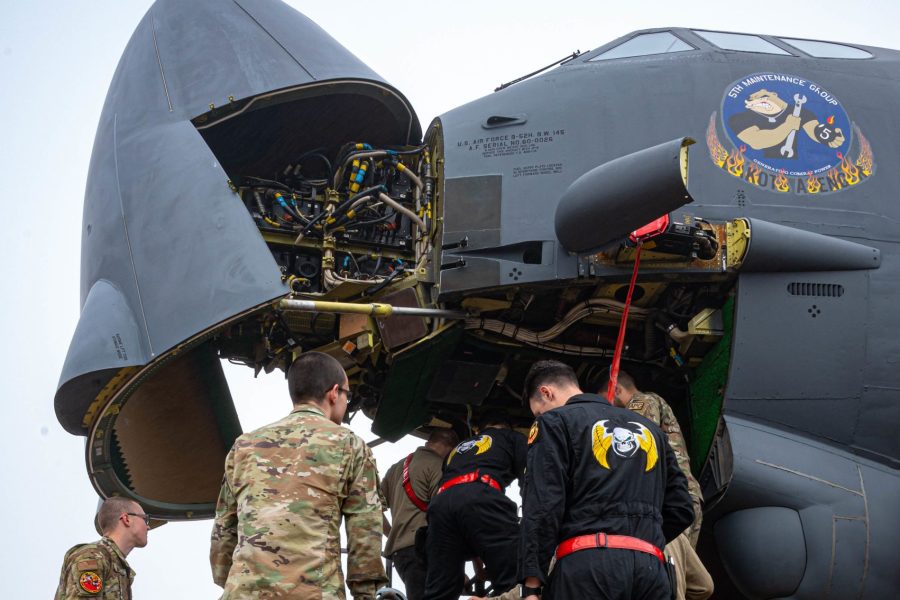The B-52‘s new radar will soon enter flight testing and is “turning a corner” after a cost overrun triggered a notification to Congress and program review earlier this year, a top general said Aug. 27.
Lt. Gen. Andrew J. Gebara, deputy chief of staff for strategic deterrence and nuclear integration, also said he expects a second B-21 to start flying before the end of 2025, part of a raft of nuclear program updates he offered during an event with AFA’s Mitchell Institute for Aerospace Studies.
“I believe that we are very close to getting that first radar to Edwards Air Force Base to begin flight test,” Gebara said of the B-52’s new hardware. “I don’t have a specific date for you today, but I believe that is turning a corner, and I’m very eager, as a former B-52 pilot, very eager to see that get underway.”
The B-52 Radar Modernization Program, one of the central upgrades for the new B-52J configuration, is meant to replace the long-obsolete and problem-prone analog AN/APQ-166 radar with the new Raytheon AN/APQ-188.
In May, the Air Force confirmed that the program had suffered a “Nunn-McCurdy breach,” meaning the expected unit cost had risen enough to trigger the Nunn-McCurdy Act. That law requires the services to tell Congress when there has been a “significant” increase in a program’s cost or schedule estimate from its approved baseline, defined as at least 15 percent. A “critical” breach of cost or schedule—defined as a 25 percent increase—requires the Defense Department to certify the program as necessary for national security or cancel it.
The B-52 radar breach was significant but not critical, and officials said they were confident it would not get worse. To that end, they said they were reviewing the scope of the program. Gebara confirmed that the new radar may not have all the capabilities originally envisioned.
“We’re buying a radar that is largely a F/A-18 Hornet radar with some small modifications. We did that intentionally because that is what was on the market at the time. It would actually cost us more if we asked to design a new radar,” he said. “Having said that, it doesn’t mean that we need everything on that radar that the Hornet has on it, right? We have a certain number of [minimum] things that we need to do to be able to do our B-52 mission. And so part of the cost savings was looking at, what are those things, to make sure that we’re prioritizing precious dollars on things that we need, and not that are good ideas or that we want or the like?”
Yet he didn’t close the door on those upgrades completely, noting that “that does give us opportunities for growth in the future if it comes to that.”
In March, the service put out a request for information asking industry about other “modified” radars that could be supplied off the shelf to equip the B-52, but cautioned that it was “not a solicitation” and was published for “informational purposes only.”
Gebara confirmed that the Air Force would not be switching its selection.
“I don’t believe we’re going to select a different radar. I think we’re continuing with the radar we have, and I believe it’s going to be flying to Edwards in the short term,” he said.

B-21
Alongside the upgraded B-52, the new B-21 Raider is meant to be the backbone of the future Air Force bomber fleet. On that front, Gebara reiterated comments last month from Air Force Global Strike Command boss Gen. Thomas A. Bussiere that a second B-21 is slated to enter flight testing “soon.”
“We’ve done the initial R&D work; we’ve started flight test; I think we publicly stated recently that we believe the second aircraft will take to the sky soon,” Gebara said. “So all these things are great indicators of success and a program that’s on time, on budget, and producing.”
Asked later if that means the second B-21 will start flying before 2026, Gebara indicated it likely would while leaving room for changes.
“I believe it will happen before the end of the year, but we’re not going to ever give them an artificial date that they have to make if it doesn’t bring the test program along to where they need to be,” Gebara said. “And so, you know, we’re going to proceed as we can, efficiently, effectively, and with a sense of urgency, but we’re also going to be event-based. And that’s really been the secret sauce to the B-21 right now, is no undue pressures. Let them do what they’re doing, and they’ll get us the world’s best aircraft here very soon.”
Gebara also added his voice to the growing chorus of top generals and Pentagon officials saying the B-21 program may need to expand beyond its current plan of 100 airplanes.
“I believe our nuclear deterrent force and the program of record we have for it is absolutely necessary, but may be insufficient for the future, based on the fact that this was designed in between the Cold War and the world we live in today,” he said. “ … The question, then, is really: if it may be insufficient, what do we need to do to make it sufficient in the future? That’s the work that still has to be done.
“And that’s more than just B-21, that’s across the breadth and width of our capabilities. B-21 numbers will absolutely be reliant on the work [U.S. Strategic Command] is doing on what is sufficient, but it’s important to remember this is also the backbone of our conventional force. And so we aren’t building out B-21 numbers only for our triad. We’re also building it out for our long-range strike capability. And so all that will go into it.”
Yet while others have called for specific totals like 145 B-21s, Gebara did not say how many bombers he thinks are needed, or even a timeline for when that decision will be made. While Congress added billions of dollars in reconciliation funding to accelerate B-21 production, he said it will take time to add that capacity.
“Largely the number of B-21s that can come out in the early years is what it is until we get that work done,” he said. “So the decision on, is it greater than 100, is it 145, is it some other number? That’s not really going to be affected if we made that decision today, it really doesn’t affect for several more years. And so I, like you, I’m eager to find out what that number is. But the reality is that’s going to be something that’s worked for a long time.”


